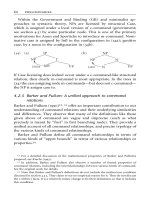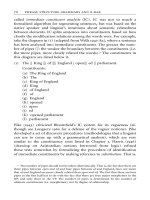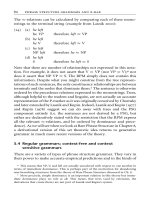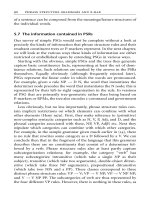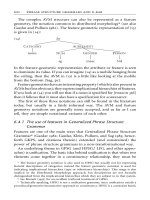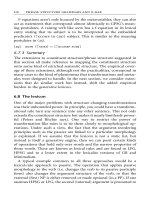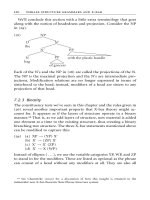Constituent Structure - Part 15
Bạn đang xem bản rút gọn của tài liệu. Xem và tải ngay bản đầy đủ của tài liệu tại đây (106.65 KB, 10 trang )
We’ll conclude this section with a little extra terminology that goes
along with the notion of headedness and projection. Consider the NP
in (29).
()
NP
D
the
NЈ
NЈ PP
N
bag
PP
with the plastic handle
of
grocers
Each of the N’s and the NP in (28) are called the projections of the N.
The NP is the maximal projection and the N’s are intermediate pro-
jections. ModiWcation relations are no longer expressed in terms of
sisterhood to the head; instead, modiWers of a head are sisters to any
projection of that head.
7.2.3 Binarity
The constituency tests we’ve seen in this chapter and the rules given in
(26) reveal another important property that X-bar theory might ac-
count for. It appears as if the layers of structure operate in a binary
manner.10 That is, as we add layers of structure, new material is added
one element at a time to the existing structure, thus creating a binary
branching tree structure. The three X-bar statements mentioned above
can be modiWed to capture this:
(29) (a) XP ! (YP) X’
(b) X’ ! (ZP) X’
(c) X’ ! X’ (ZP)
(d) X’ ! X (WP)
Instead of ellipses ( ...),weusethevariable categories YP, WP, and ZP
to stand in for the modiWers. These are listed as optional as the phrase
can consist of a head without any modiWers at all. They are also all
10 See Chametzky (2000) for a discussion of how this insight is retained in the
minimalist non-X-bar-theoretic Bare Phrase Structure system.
120 phrase structure grammars and x-bar
listed as phrasal, including the one in (29a), which is typically occupied
by a bare determiner. We will return to this contradiction below.
Binarity is a common—but by no means universal—part of X-bar
theory.
7.2.4 Distinctions among modifier types
Given our three types of rule, which introduce three distinct layers of
structure, we predict that we should have at least three distinct types of
head-modiWers. This appears to be true. We Wnd good evidence that we
need to distinguish among speciWers (the YP in the XP ! (YP) X’ rule),
adjuncts (the ZP in the X’ ! (ZP) X’ and X’ ! X’ (ZP) rules) and
complements (the WP in the X’ ! X (WP) rule).11
Consider the two prepositional phrases that are subconstituents of
the following NP:
(30) the bag [
PP
of groceries] [
PP
with the plastic handle]
Using the X-bar schema, we can generate the following tree for this NP:
()
NP
D
the
NЈ
NЈ
PP
2
sister to a bar level
N
PP
1
with the plastic handle
bag
sister to a hea
d
of groceries
You will note that the two PPs in this tree are at diVerent levels in the
tree. The lower PP
1
is a sister to the head N (bag), whereas the higher
PP
2
is a sister to the N’ dominating the head N and PP
1
. Notice also
that these two PPs were introduced by diVerent rule types. PP
1
is
11 Napoli (1989) argues against this distinction referring to the reverse ordering of
adjuncts and complements in Italian NPs such as:
(i) la distruzione brutale de Troia
the distruction brutal of Troy
spec head adjunct complement
‘‘the brutal destruction of Troy’’
See Longobardi (1994) for an alternative analysis that involves movement of the head
around the adjunct to its surface position.
x-bar theory 121
introduced by the rule meeting the X’ ! X (WP) schema and PP
2
is introduced by the higher-level rule type (X’ ! X’ (ZP)).
An XP that is a sister to a head is a complement.PP
1
is a comple-
ment. XPs that are sisters to single-bar levels and are daughters of
another bar level are adjuncts.PP
2
in (31) is an adjunct. The third
type of modiWer is a speciWer. These are sisters to the bar level and
daughter of a maximal category. The determiner in (31) is a speciWer.
If we abstract away from speciWc categories we can distinguish
among modiWers as seen in (32).
()XP
YP XЈ
specifier
adjunct
XЈ ZP
complemen
t
XWP
We predict these diVerent kinds of modiWer to exhibit diVerent behav-
iors. We’ll concentrate Wrst on the distinction between complements
and adjuncts then turn to speciWers.
Take NPs as a prototypical example. Consider the diVerence in
meaning between the two NPs below:
(33) (a) the bag of groceries
(b) the bag with a plastic handle
Although both these examples seem to have, on the surface, parallel
structures (a determiner followed by a noun followed by a prepos-
itional phrase), in reality they have quite diVerent structures. The PP
in (33a) is a complement and has the following tree:
()NP
D
the
NЈ
N
bag
PP
of
groceries
You will note that the circled PP is a sister to N, so it is a complement.
By contrast, the structure of (33b) is:
122 phrase structure grammars and x-bar
N
ba
g
()NP
D
NЈ
NЈ
PP
with a plastic handle
Here the PP with a plastic handle is a sister to N’, so it is an adjunct.
Observe that rules that introduce complements also introduce the
head (X). This means that the complement will be both adjacent
to the head and more importantly closer to the head than an adjunct.
(36) the bag [of groceries] [with a plastic handle]
head complement adjunct
(37) ??the bag [with a plastic handle] [of groceries]
head adjunct complement
Since the adjunct rules take an X’ level category rewrite it as an X’
category, adjuncts will always be higher in the tree than the output of
the complement rule (which takes an X’ and rewrites an X). Since lines
can not cross, this means that complements will always be lower in the
tree than adjuncts, and will always be closer to the head than adjuncts.
The adjunct rules are iterative. This means that the rule can generate
inWnite strings of X’ nodes, since the rule can apply over and over again
to its own output:
()XЈ
XЈ YP
XЈ YP
XЈ
etc.
YP
…
Complement rules do not have this property. On the left side of
such rules there is an X’, but on the right there is only X. So the rule
cannot apply iteratively—that is, it can only apply once within an XP.
What this means for complements and adjuncts is that you can
x-bar theory 123
have any number of adjuncts (39), but you can only ever have one
complement (40):
(39) the book [of poems] [with a red cover] [from Oxford]
head complement adjunct adjunct
[by Robert Burns]
adjunct
(40) *the book [of poems] [of Wction] [with a red cover]
head complement complement adjunct
The tree for (39) is given below; note that since there is only one N,
there can only be one complement, but since there are multiple N’s,
there can be as many adjuncts as desired.
()
D
NP
NЈ
NЈ PP
NЈ PP
by Robert Burns
NЈ PP
from Oxford
N
book
PP
with a red cover
of poems
It also follows from the iterative nature of adjunct rules that adjuncts
can be reordered with respect to one another, but one can never
reorder a complement with the adjuncts:
(42) (a) the book of poems with a red cover from Oxford by Robert
Burns
(b) the book of poems from Oxford with a red cover by Robert
Burns
(c) the book of poems from Oxford by Robert Burns with a red
cover
(d) the book of poems by Robert Burns from Oxford with a red
cover
(e) the book of poems by Robert Burns with a red cover from
Oxford
124 phrase structure grammars and x-bar



